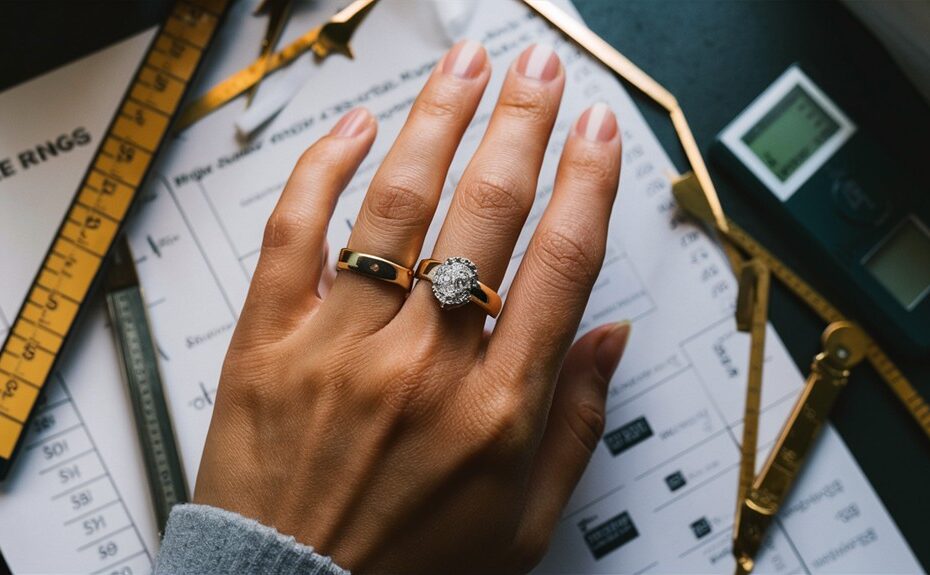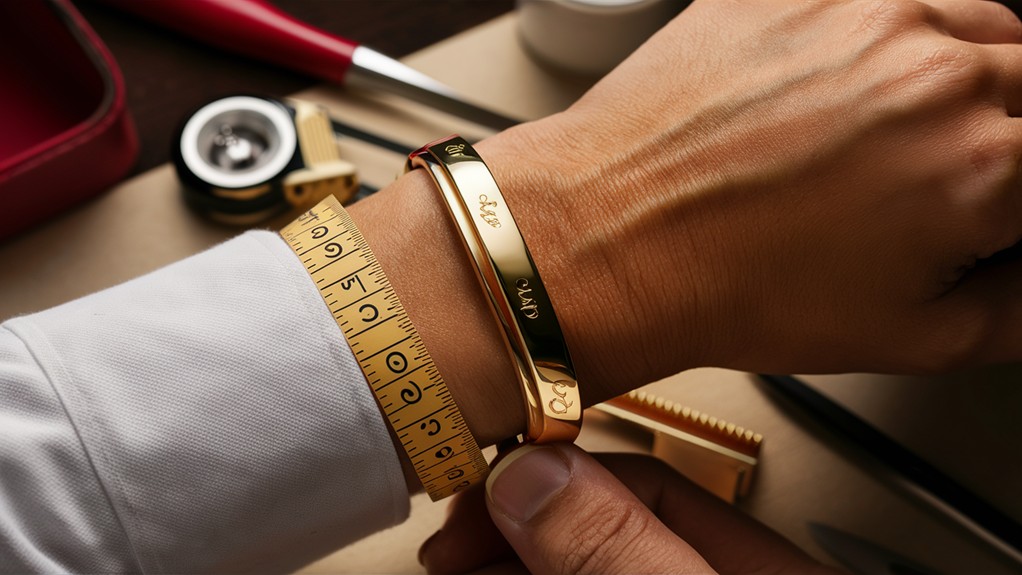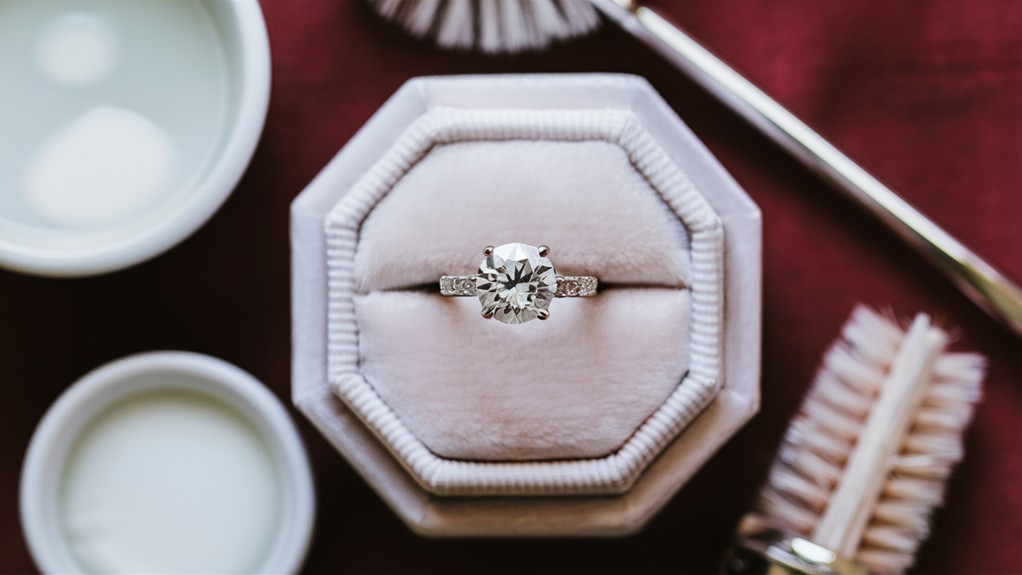When you're shopping for a ring, finding the perfect fit can be tricky. You might be surprised to learn that your height and weight can actually help determine your ring size. This unconventional method offers a quick starting point for those unsure about their measurements. While it's not foolproof, understanding the correlation between physical attributes and ring size can save you time and frustration. But how accurate is this approach, and what factors should you consider when using a height-weight ring size calculator? Let's investigate the ins and outs of this intriguing sizing technique.
Our Highlighted Points
- Consult a Ring Size by Height and Weight chart for an initial estimate of your ring size.
- Measure your finger's circumference with a flexible tape or string for more accurate sizing.
- Consider daily and seasonal variations in finger size due to temperature and other factors.
- Use the inner diameter of a well-fitting ring as a reference for precise measurements.
- Seek professional jeweler assistance for the most accurate ring sizing, especially for unique finger shapes.
Understanding Height-Weight Ring Sizing

Determining your ring size can be tricky, but understanding the relationship between height, weight, and ring size can help. To find your ring size accurately, consider using a Ring Size by Height and Weight chart. This method provides a general guideline for average ring sizes based on your physical attributes.
For instance:
- If you're 5'3" or shorter and weigh around 130 lbs, your ring size likely falls between 4-6.
- Standing 5'4" to 5'6" and weighing about 140 lbs? Expect sizes 4.5-7.5.
- Those 5'7" to 5'9" and 150 lbs typically wear sizes 5.5-8.
- If you're 5'10" or taller and weigh around 160 lbs, consider sizes 6-9.
Remember, these are averages, and your perfect fit may differ.
To guarantee accuracy:
- Measure your finger multiple times throughout the day.
- Use a proper ring size measurement tool.
- Consider factors like temperature and hand activity.
While height and weight provide a starting point, they're not definitive.
For the most accurate ring size, combine this method with professional sizing or at-home measurement techniques to achieve that elusive perfect fit. Professional sizing from a jeweler will provide the most precise measurement, while at-home techniques can also be useful for a quick estimate. Additionally, considering the specific dimensions of the piece, such as the Cartier love bracelet dimensions, can also play a crucial role in ensuring the perfect fit. By taking all of these factors into account, you can be confident that your ring will be comfortable and secure on your finger.
Benefits of Using Physical Attributes
One of the key advantages of using physical attributes for ring sizing is the personalized approach it offers. By considering your height and weight, you can utilize a Ring Size Calculator to achieve more accurate results than relying on generic sizing methods solely. This approach takes into account the correlation between body mass and finger sizes, providing a tailored estimate that's particularly useful if you're unfamiliar with ring sizing.
Using physical attributes in conjunction with a ring size chart can help you:
- Narrow down your average ring size range
- Reduce the likelihood of costly resizing
- Increase the chances of selecting the perfect ring size on your initial attempt
For instance, if you're 5'3" or below and around 130 lbs, you'll likely fall within sizes 4-4.5 or 5.5-6. Conversely, if you're 5'10" or taller and around 160 lbs, you may wear sizes 6-7 or 8-9.
Step-by-Step Measurement Process
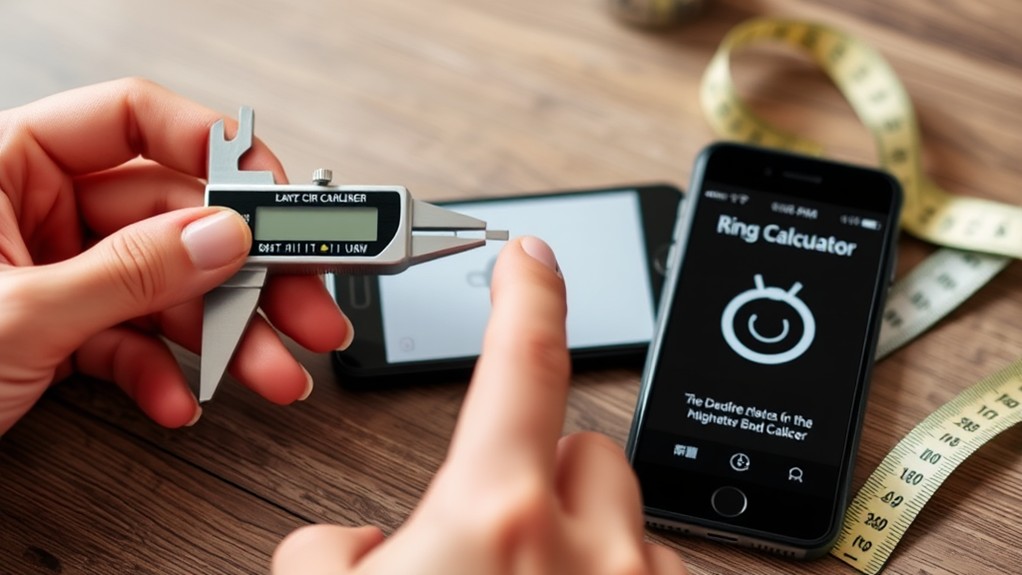
To accurately measure your ring size at home, follow these simple steps:
1. Begin by measuring your height and weight. These physical attributes can provide a general guideline for estimating your ring size. For example, if you're 5'3" or shorter and weigh around 130 lbs, you may wear sizes 4-4.5 or 5.5-6.
2. Use a string or flexible measuring tape to measure your finger:
- Wrap it around the base of your finger
- Mark where it overlaps
- Measure the length in millimeters
3. Consult a ring size chart to find your corresponding ring size based on the finger circumference you've measured.
4. Consider daily variations in finger size resulting from temperature or activity. Measure when your finger feels average-sized.
5. For added precision, measure the inner diameter of a well-fitting ring you already own:
- Use a ruler to measure the diameter in millimeters
- Cross-reference this measurement with a ring size chart
Accuracy and Limitations
While height and weight can provide a general starting point for estimating ring size, they're not foolproof indicators. Accuracy can be affected by individual variations in finger shape, hand size, and personal preferences.
For instance, individuals between 5'7" and 5'9" weighing around 150 lbs typically wear sizes ranging from 5.5 to 8, but this range may not apply to everyone.
Several limitations exist when using height and weight for ring sizing:
- Knuckle size and hand dominance can impact fit, requiring adjustments beyond basic measurements.
- Seasonal changes in body weight and temperature can cause fluctuations in finger size.
- Individual finger proportions may not align with general height and weight correlations.
To improve accuracy, consider these additional fitting techniques:
- Use a ring sizer or string measurement method for precise sizing.
- Consult a professional jeweler for expert guidance.
- Account for lifestyle factors, such as exercise habits or occupation, that may affect finger size.
Adjusting for Individual Variations
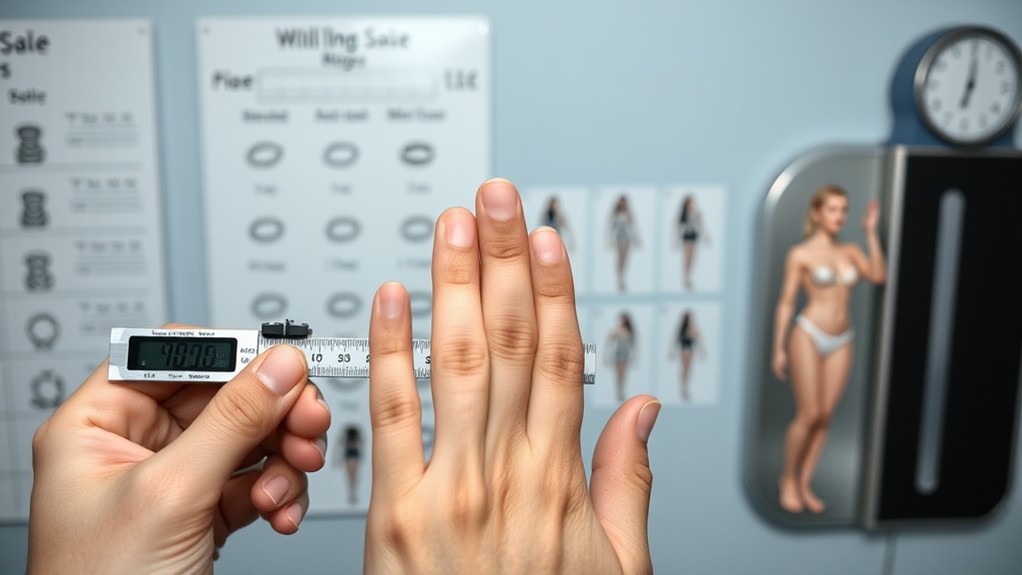
While height and weight provide a starting point for ring sizing, you'll need to account for individual variations to ascertain a perfect fit. Consider these factors when adjusting your ring size:
- Dominant hand: Fingers on your dominant hand may be up to half a size larger than those on your non-dominant hand.
- Knuckle size: Measure both the base of your finger and around the knuckle to ascertain comfortable passage over larger knuckles.
- Seasonal changes: Temperature fluctuations can cause fingers to shrink or swell. Measure at consistent times and in similar weather conditions for accuracy.
- Personal characteristics: While height and weight guide estimations, your unique traits may deviate from average size guidelines.
- Genetic background: Family history of larger finger sizes may influence your ring size.
- Occupation: Physically demanding jobs can affect finger size over time.
To account for these variations:
- Use a professional ring sizer or printable ring size chart for precise measurements.
- Consider ring resizing options if needed, especially for heirloom or custom pieces.
- Consult with a jeweler to discuss your specific needs and potential adjustments.
Frequently Asked Questions
What Is My Ring Size Based on Height and Weight?
Your ring size depends on your height and weight. If you're shorter and lighter, you'll likely wear a smaller size. As you get taller and heavier, your ring size typically increases. Consider these factors when choosing your ring.
How Do I Know My Perfect Ring Size?
To determine your perfect ring size, you'll need to take into account your height, weight, and hand size. Measure your finger at different times of day, as it can fluctuate. For accuracy, you should visit a jeweler for professional sizing.
How to Figure Out Ring Size Calculator?
To figure out a ring size calculator, you'll input your height and weight. These factors correlate with average sizes. For accuracy, measure your finger's circumference initially. The calculator will then provide a personalized estimate based on your physical attributes.
How Much Does Your Ring Size Change With Weight?
Your ring size can change considerably with weight fluctuations. You'll typically see a half to full size increase for every 10-15 pounds gained. Remember, it's not merely about weight; your body composition likewise plays a role.
